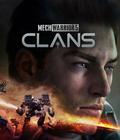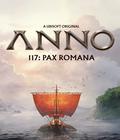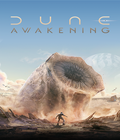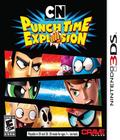In such a short time span, the Nintendo 3DS has already been home to no fewer than three fighting games, each one a classic representative of the various fighting subgenres. For their polygonal fix, 2-D side-scrolling fighting enthusiasts can either play Super Street Fighter IV: 3D Edition or BlazBlue: Continuum Shift II. Then there's Dead or Alive: Dimensions for those who prefer their fighting in a 3-D space. BlayzBloo: Super Melee Brawl is for 3-D arena fighting enthusiasts who don't mind digging into the back catalog of DSiWare games. Despite this, one fighting subgenre not represented natively on the system is the 2-D arena fighter popularized by Nintendo's Super Smash Bros. series. It was announced that the series would finally make the leap to the portable realm, but that project has no release date attached. In the meantime, Crave Games and Papaya Studios have come up with the next best thing in Cartoon Network Punch Time Explosion.
The plot will be familiar to those who have played crossover fighting games before, but there's enough of a comedic slant to make it feel fresh. On a rare day off, an announcer decides that he simply wants to spend his time watching some of the fine shows on Cartoon Network. Much to his surprise, though, the shows that he's watching are all mixed up. Missiles are dropping toward the Sector 5 tree house of Codename: Kids Next Door and Vilgax, one of the main villains from Ben 10, is appearing on Chowder while the cast from that show is suddenly evil. Ben Tennyson shows up on the scene, chasing Vilgax as he warps from one show to another. It's up to the teenage alien-changing hero and his newly freed friends from every show to band together, stop Vilgax, and find a way to make things change back to normal.
For a fan of Cartoon Network, Cartoon Network Punch Time Explosion is almost a dream come true, as the game involves the casts and sets from various shows the network has created over the years. The shows also provide a wide mix of eras, with "Dexter's Laboratory," "Johnny Bravo" and "The Powerpuff Girls" representing the early days of the network, "Foster's Home for Imaginary Friends" and "The Grim Adventures of Billy and Mandy" representing the middle period, and "Ben 10," "Chowder and The Marvelous Misadventures of Flapjack" representing more recent fare. All in all, there are 11 different Cartoon Network shows represented, including one from before the network was even born.
Fans of the network will no doubt have concerns about characters that have been excluded from the game. Over the years, the network has had quite a stable of original characters to complement the other licensed fare. Even though they appeared on the channel, one wouldn't expect the cast of "Atomic Betty," "Johnny Test," "Teen Titans" and "Totally Spies" to show up because they weren't originally considered part of the Cartoon Network universe. However, it's puzzling to see the likes of "Adventure Time," "Camp Lazlo," "Courage the Cowardly Dog," "Evil Con Carne," "Megas XLR" and "Regular Show" go missing in action, especially since some of those shows were network mainstays for so long. While they may show up in the upcoming console versions of the game, their absence here, along with the absence of characters from other Cartoon Network original shows, makes the cast feel incomplete.
The fighting system should be very familiar to those who have played any iteration of Super Smash Bros. No matter which fighter you pick, you always have a choice between two different attacks: normal and special. Though each can be used on its own to inflict damage or start up combos, you can uncover more moves by using those buttons in conjunction with directions on your circle pad. Beating up on enemies gives you power cubes that fill up a meter on the touch-screen, and once that meter is full, you can unleash an attack that inflicts major damage or clears the screen of opponents. Aside from your own moves, you can pick up items on the battlefield to use against the opposition and call upon other Cartoon Network characters in defensive or offensive support roles. Instead of an energy meter, you have a damage percentage meter, and the higher that goes, the more likely it is you're going to fly off-screen — and that's the only way to get defeated in the game aside from falling into pits.
There are two modes available for solo players. Story mode is very similar to the Subspace Emissary mode from Super Smash Bros. Brawl. Here, you're limited to the characters provided per mission, but you'll engage in some basic arena fights between lots of platforming areas. While most of the mode consists of jumping over pits and beating up enemies, there are a few little tricks thrown in for good measure. Some areas have you trying to use a giant slingshot to hurl items at enemies or ships blocking your path while other areas have you flying through the air and manning a gunship or turret to take out airborne threats. In a way, these little touches make it more varied than you'd expect in a story mode from a similar game, and it also helps that some of the dialogue evokes the humorous spirit of some of the cartoons it features.
Battle mode is your standard versus mode, where you can go up against a maximum of three CPU-controlled opponents in any of the unlocked levels. The rules are the same as Story mode, minus the platforming and shooting levels, and you can customize a few things, such as lives in a match, length of time and the frequency of items showing up. Though one may think that this mode is only good for practicing, keep in mind that this is the only way to unlock characters that aren't available in Story mode, so it ends up being a worthwhile endeavor.
At its core, the fighting mechanics are simple but good. There's some thought put into the simple button-mashing, so simply spamming the same attack button over and over again won't always guarantee victory. Item use is well implemented, and while everything pretty much acts the same way and implements a similar amount of damage, it's nice to see it varied even if it's only cosmetic. One interesting twist thrown into the formula has to do with the special helper characters that can be called upon when you pick up a Cartoon Network icon in the field. For the most part, you'll get helpers that benefit you in some way, but there are more than a few that simply hurt everyone in their paths, no matter who picks up the icon. While it can be a nasty surprise for the one who picks up the icon, it stays true to the lore if the icons hurt everyone indiscriminately.
There are a few issues plaguing Cartoon Network Punch Time Explosion, though. There are times when some activities in Story mode come with no explanation of controls. A good example of this is during one of the "Codename: Kids Next Door" sequences, where you see Numbuh One hop on a flying bus to go and stop Stickybeard's ship. During gameplay, you see the bus get attacked, and nothing happens to the vehicle when you press buttons. It's not until a few moments later when you realize that you aren't controlling the bus but the gunship above and to the right of the bus, and even then, it's only the turret. It also doesn't seem to contain any real depth to the fighting mechanics. Unlike Nintendo's fighting title, there's no good way to get better at the game. Whatever you find during the first few minutes with the game will be what you find several hours into the game, and there aren't any hidden techniques or moves to be discovered. Finally, there were quite a few instances where the game simply crashed in Story mode. The crashes were bad enough that the system would shut down after a period of time, and while that may be acceptable when too much is going on at once, this occurred when nothing was happening in the game.
The multiplayer is interesting in terms of what it includes and what it omits. As expected, multiplayer can be accomplished with up to four players, each one having his or her own system and copy of the game. However, the game takes things one step further by offering up download play as well, so those who don't have the game can still play along. It has a few limitations, such as the inability to unlock new characters for the host should he/she win the match. You only get to fight in the first level of Samurai Jack's world, and you only get to fight with either Ben Tennyson, Buttercup, Dexter or Numbuh One. Despite that, it's great to see the game take advantage of a feature that no fighting game has done yet on the system. One thing the game doesn't do with multiplayer, though, is online play. With every other fighting game taking things online, it's sad to see this title not attempt that.
The graphics are quite good, though they feel small on the portable console because of the amount of zoom on the camera during most of the levels. The fighters look great and true to their original artwork, even though many haven't been rendered in 3-D prior to this game. They also move quite nicely and show off some good particle effects anytime they get hit or unleash projectile attacks. The environments are even better, with some great details strewn about, such as bystanders going about their business while you fight. Artwork also matches the original animated style of the series. All of it moves at a smooth 60 frames per second, a speed that's always preferred for a fighting game. Aside from the camera zoom making everything look smaller than normal, one complaint has to do with the cut scenes, which are nothing more than moving still pictures instead of fully animated pieces. While it doesn't necessarily affect gameplay, it would've made the game look higher in quality if those scenes were as animated as the source material.
Of all of the games that have come out so far during the 3DS' short life on shelves, this is one of the few that uses the 3-D effect without any drawbacks. You truly do get a sense of depth when the 3-D is on, and there's never an instance when it's used purely as a gimmick or crutch. In fact, in some environments, such as most of the Flapjack levels, it makes it look better since there's a more artistic separation of the waves at work. Best of all, there's no performance degradation or other graphical flaws seen in 3-D compared to what's seen in 2-D.
The sound in the game is very hit-or-miss. The effects are fine, but they begin to sound distorted during the punch time explosion moves, especially any move that involves gunfire and explosions. There is music in the game, but you'll likely only hear it during the title screen and end credits. During gameplay, the music volume is so low that it gets overwhelmed by the sound effects, and you'll only ever notice when you stand perfectly still and no enemies are around you. Most of the voices are done by the characters' original voice actors, and those that aren't have fairly good impersonators performing the task. You won't get a chance to appreciate their work, though, since they're limited to a few lines in battle and a sound bite or two during cut scenes. Despite having lines of dialogue written out for them on the screen, just about everyone will simply utter a "Hi," or a catchphrase when it's their turn to speak. The exception would be the announcer George Lowe, who some may remember as the titular character from "Space Ghost: Coast to Coast." All of his lines are spoken, and his pitch-perfect delivery fits well with the game's wacky plot.
Cartoon Network Punch Time Explosion is a decent fighting game. The fighting may be simpler than expected, but the adventure portion is decent, and there are a sizable number of famous Cartoon Network characters. It looks excellent in both 2-D and 3-D, but the sound could have been much better. Like any good fighting game, it's more fun with friends, and while download play is a great feature to have, online play would have made it more enticing. Overall, it's good enough to play once in a while, but unless you're a big Cartoon Network fan, don't expect it to get the same amount of play time as the other fighting games on the system.
Score: 7.5/10
More articles about Cartoon Network Punch Time Explosion XL











 Cartoon Network Punch Time Explosion is a crossover fighting game with 18 playable characters from 11 different Cartoon Network shows where you can battle in 21 different arenas, as well as fight through an original story-driven adventure.
Cartoon Network Punch Time Explosion is a crossover fighting game with 18 playable characters from 11 different Cartoon Network shows where you can battle in 21 different arenas, as well as fight through an original story-driven adventure.




















